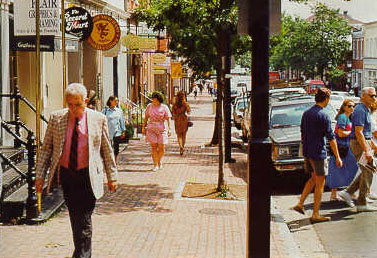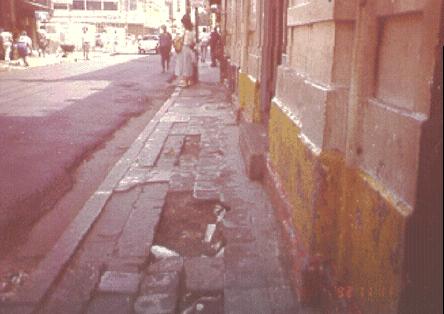U.S. Department of Transportation
Federal Highway Administration
1200 New Jersey Avenue, SE
Washington, DC 20590
202-366-4000
Federal Highway Administration Research and Technology
Coordinating, Developing, and Delivering Highway Transportation Innovations
 |
| This report is an archived publication and may contain dated technical, contact, and link information |
|
Publication Number: FHWA-RD-98-166
Date: July 1999 |
Guidebook on Methods to Estimate Non-Motorized Travel: Supporting Documentation2.17 Environment Factors
Descriptive Criteria: What is It? Categories: Purpose: Pedestrian and bicycle environment factors describe the friendliness of an area (such as a city block, census tract, or traffic analysis zone) for walking and/or bicycling. Pedestrian and bicycle environment factors have been developed primarily for use in regional travel models, where they are applied at a zonal level to predict mode choice and/or automobile ownership. These factors may be used to predict trips that are made by transit as well as entirely by non-motorized modes, since the likelihood of making a trip by transit may be influenced by the quality of the pedestrian environment around transit stations. Environment factors can also be used to prioritize areas for pedestrian or bicycle improvements, based on their rating. Structure: Environment factors are quantitative and may be a composite of a number of quantitative descriptors and/or subjective factors that have been quantified through an ordinal rating. Examples of factors considered include lane or sidewalk width, street continuity, topography, and the aesthetic quality of the environment. The specific factors included, and the means of aggregating them into an overall index, vary according to the application. Portland's Pedestrian Environment Factor (PEF), developed for use in its regional travel model, includes four elements:
Each zone is ranked for each element on a scale of zero to three, with higher numbers representing higher quality pedestrian environments, so the overall PEF can range from 0 to 12. A Pedestrian and Bicycle Environment Factor (PBEF) includes an additional three-point rating for bicycle facilities, so the PBEF can range from 0 to 15. Montgomery County's PBEF includes five elements:
Each factor can be rated at various levels for which specific fractional points are assigned (e.g., 0.00 for "little or no bicycle infrastructure," 0.05 for "some bicycle paths or routes," 0.10 for "many bicycle paths, lanes, or routes forming network"), yielding an overall PBEF of between zero and one for each zone. A "Transit Friendliness Factor" developed to predict auto vs. transit mode choice in Raleigh, NC includes ratings on a scale of one through five for four elements:
Calibration/Validation Approach: In theory, the elements included in each factor, and the weights applied to each element, could be validated through actual surveys of pedestrians or bicyclists to determine which factors are most important. Validation of the factors has not been performed in practice. Inputs/Data Needs: Various local land use and environmental data are required, according to the elements contained in the index. Potential Data Sources: Some data may be obtained from data bases of land use or facility characteristics (i.e., presence of sidewalks by street segment). Other data may need to be collected through fieldwork. Computational Requirements: Computational requirements for environment factors are minimal. User Skill/Knowledge: Knowledge of local land use and/or facility data bases is required. Also, in many cases, field data collection will be subjective and require judgment on the part of the observer. Assumptions: It is assumed that the elements contained in the environment factor adequately represent the attractiveness of the area to bicyclists or pedestrians, i.e., correlated with the traveler's decision to bicycle or walk. Furthermore, with combined bicycle and pedestrian environment factors, it is assumed that the same elements of environmental quality influence both bicycling and walking in the same manner. Facility Design Factors: A variety of factors can be considered. Examples of factors used include lane or sidewalk width, street continuity, topography, and the aesthetic quality of the environment (see "Structure" for further details). The factors included are generally limited by data availability. Output Types: The result is a numerical rating of the friendliness of an area for bicycling and/or walking. Real-World Examples: A Pedestrian Environment Factor has been developed and applied to the regional travel model in Portland, OR, and modified versions have been applied in Sacramento, CA, and Washington, DC. Montgomery County, MD, has developed a different Pedestrian/Bicycle Environment Factor for use in its travel model. The application of factors in Portland has been described in 1,000 Friends of Oregon (1992 - 1997), Cambridge Systematics (1994), and Rossi (1993). The application of factors in Montgomery County has been described in Cambridge Systematics (1994). The application of factors in the Washington, DC region has been described in Chesapeake Bay Foundation, et al. (1996). Evans, Perincherry, and Douglas (1997) developed a "Transit Friendliness Factor" describing the quality of pedestrian access to transit. This factor was applied in a sketch-planning mode choice model for the Triangle Transit Authority in Raleigh, NC. Several research efforts have sought to identify the effects of various site design, neighborhood characteristics, and other environmental factors on travel behavior. The results of such research could be useful in determining which elements to include and which weights to assign, and in constructing environment factors. Contacts/Source: John Evans (Transit Friendliness Factor): Parsons Brinckerhoff Quade and Douglas Inc., Baltimore, MD Michael Replogle (environment factors in Montgomery Co., MD, and Washington, DC): Environmental Defense Fund, Washington, DC. 
 Figure 2.17: Pedestrian environments vary widely in their quality. Tom Rossi (environment factors in Portland, OR, and Washington, DC): Cambridge Systematics Inc., Cambridge, MA 1,000 Friends of Oregon (environment factors in Oregon): http://www.teleport.com/ Publications: Cambridge Systematics, Inc. Short-Term Travel Model Improvements, Travel Model Improvement Program. U.S. Department of Transportation; DOT-T-95-05, pp. 2-1 to 2-7, October 1994. (1994a). Chesapeake Bay Foundation, Environmental Defense Fund, et al. A Network of Livable Communities: Evaluating Travel Behavior Effects of Alternative Transportation and Community Designs for the National Capital Region. Washington, DC, May 1996. Evans, John E., IV. Vijay Perincherry, and G. Bruce Douglas, III. Transit Friendliness Factor: An Approach to Quantifying the Transit Access Environment in a Transportation Planning Model. Presented at the 1997 Transportation Research Board Annual Meeting, Paper #971435, January 1997. Rossi, Thomas. T. Keith Lawton and Kyung Hwa Kim. Revision of Travel Demand Models to Enable Analysis of Atypical Land Use Patterns. Cambridge Systematics, Inc. and Metropolitan Service District, May 1993. 1,000 Friends of Oregon. Making the Land Use Transportation Air Quality Connection: Volume 4A, The Pedestrian Environment. Portland, OR, 1993. Available at http://www.teleport.com/~friends/Lutraq2/Docs.htm. Evaluative Criteria: How Does It Work? Performance: Incorporation of environment factors has led to improvements in the Portland and Montgomery County regional travel models in terms of predicting auto versus non-auto mode split. Inclusion of a Transit Friendliness Factor in Raleigh, NC, significantly improved the performance of the model at predicting auto versus transit mode choice. Use of Existing Resources: These methods require some new data collection. Travel Demand Model Integration: Environment factors are generally designed to be used in travel models. A factor composed of any number of specific elements could be included in modeling, if data on the factor could be collected and aggregated at a zonal level compatible with existing local travel models. Applicability to Diverse Conditions: The elements included in the factors are generally relevant across regions and area types. However, specific local data collection efforts are required to develop the factors locally. Usage in Decision-Making: No information is available. Ability to Incorporate Changes: Individual elements of the factors could be changed or updated without requiring new data collection for the other elements of the factor. Ease-of-Use: The factors require collecting and managing a relatively large amount of data, but they are easy to understand and no special skills are required. However, they cannot be used by themselves to forecast bicycle or pedestrian travel. Incorporation of the factors into mode choice or regional travel models requires capability for such modeling.
FHWA-RD-98-166 |